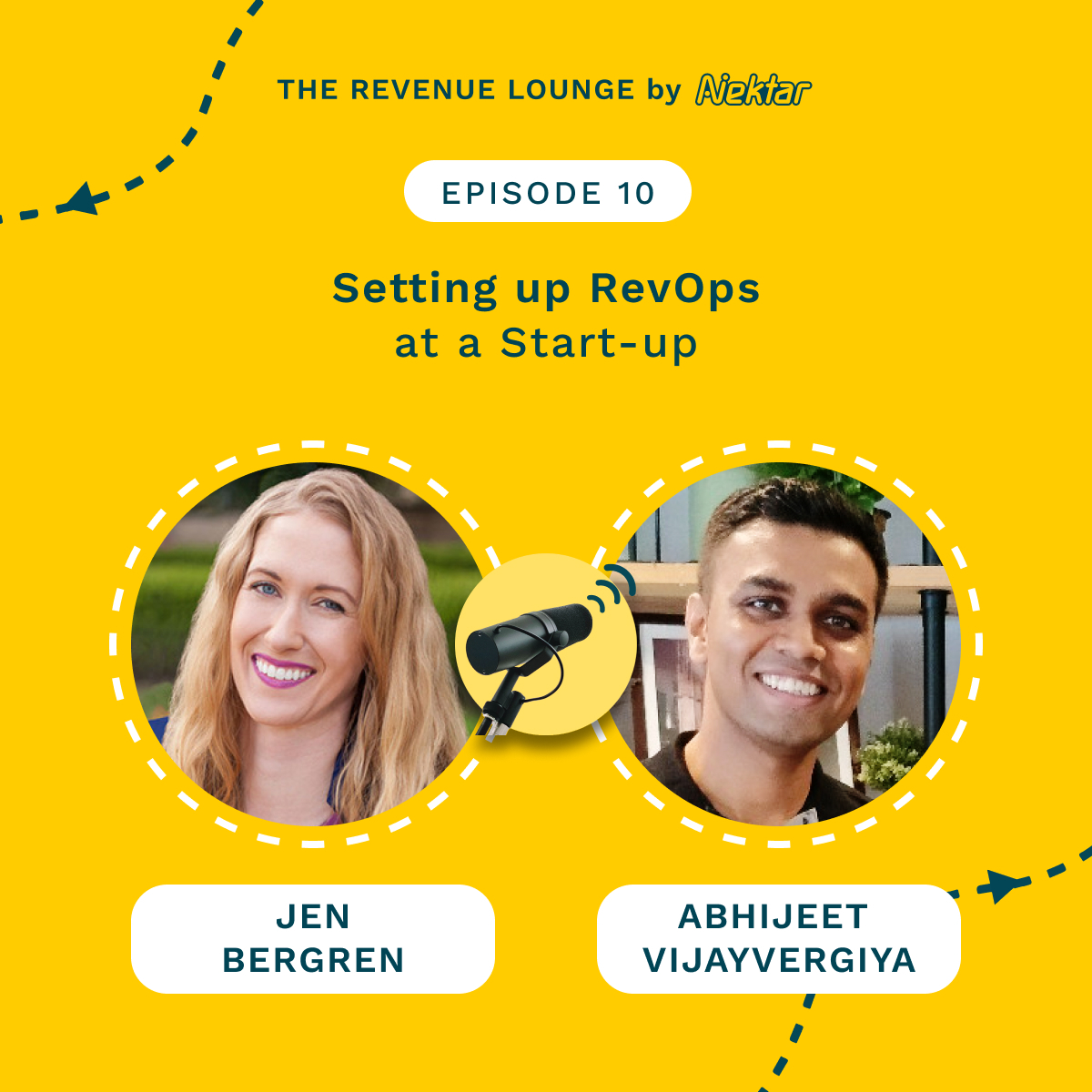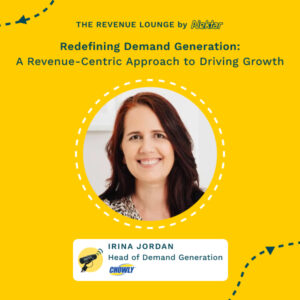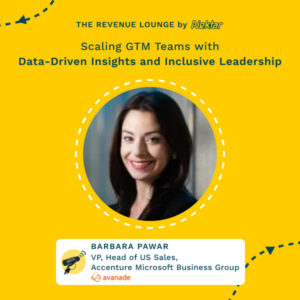Ep #7: Driving Efficient Growth With RevOps ft. Eric Welsh
May 17, 2023
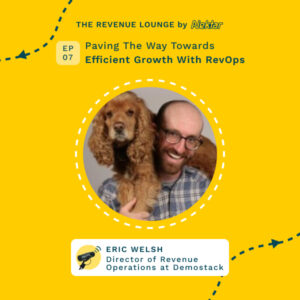
About
The Revenue Lounge
The podcast covers stories from leaders across RevOps, Sales, Customer Success, GTM, Data and Marketing about what drives these functions and what advice they would share with our listeners. With 3 seasons recorded, the podcast currently features 50+ enterprise leaders in the B2B SaaS domain. Tune in to hear from the best in the business
Welcome to Season 2 Episode 7 of The Revenue Lounge Podcast by Nektar.ai – A series of interviews with top Revenue Operations leaders on what drives the function and what keeps them going!
Episode Host – Abhijeet Vijayvergiya
https://www.linkedin.com/in/abhijeet-vijayvergiya-2571056/
Episode Guest – Eric Welsh
https://www.linkedin.com/in/ericwelsh1/
Podcast Details:
Podcast page – https://nektar.ai/podcasts/
Spotify – https://open.spotify.com/show/3DUOqnTpPOJ2xbyl7HdgN3
Google Podcasts – https://podcasts.google.com/u/0/search/the%20revenue%20lounge
Apple Podcasts – https://podcasts.apple.com/in/podcast/the-revenue-lounge/id1645044872
Episode Details:
Growth at all costs is dead. With budget freezes being implementated across organizations, revenue leaders have been asked to drive efficient growth. This means doing more with less, and using effective ways to drive productivity while keeping costs at a minimum.
But what does this really mean? How can revenue leaders pave the way towards sustainable revenue growth that withstands uncertain times?
Let’s discuss with our guest today. We have Eric Welsh who is the Director of RevOps at Demostack.
Eric is passionate about driving efficient growth. He will help us understand the nuances of sustainable growth and what it really means for RevOps in the current times.
Want to learn more about Nektar?
Talk to our team – https://bit.ly/3MishjZ
#efficientgrowth #revopsguide

[00:00:00] . Growth at all costs is dead. With budgets freezes being implemented across organizations. Revenue leaders have been asked to drive efficient revenue growth. This means using effective ways to drive productivity while keeping cost at a minimum. But what does this really mean? How can revenue leaders pave the way towards sustainable revenue growth that withstand the uncertain times we face today?
[00:00:21] Let us discuss with our guest. We have Eric Welsh, who’s the Senior Director of Revenue Operations at Demo Stack. Eric is passionate about driving efficient revenue growth. He will help us understand the nuances of sustainable growth and what it really means for revenue operations in current times. Eric, thank you for joining us today.
[00:00:38] We are very excited to learn about your journey. Yeah, my pleasure. I’m really happy to be here and share any insights I can. Yeah. Great, Eric. So to get started, when you give brief introduction about yourself, where you’re based, and how it’s been your journey into revenue operations function. Sure. Yeah. My name is Eric Welsh.
[00:00:58] I’m the director of Rev Ops at a company called DemoStack, or a demo software platform to help sales and other, um, solutions engineers demo their product. I’ve been in the rev ops or rev ops adjacent space for about 10 years, spanning from the nonprofit world where I ran operations for the development side of the house, and then all the way through the world’s design agencies.
[00:01:22] And then landing my first tech job at a company called Five Tran. At that time it was a pretty small company and they’ve skyrocketed while I was there and continued to skyrocket after I left and then came over to Demo Stack about a year and a half ago. Yeah. Amazing. So what was your entry into revenue operations?
[00:01:42] Like when did you decide to get into the function? What were those like initial founding years? Yeah, so it’s an interesting story. I started like my professional career working on tall ships, like old-fashioned wooden ships, and, uh, finding my footing in the business world. I was drawn to [00:02:00] logistics and operations, like my brain functions best when you take a mess and you turn it into something neat and tidy and clean, and it took me a while to figure out how my skills working.
[00:02:14] In like a chaotic organization, which is tall ships. You know, you’re sailing through storms, you’re trying to make order out of the weather and all these people on the ship. And I tried to translate that into work on land and operations just kept coming up While I was working in the nonprofit world, I did my M B A.
[00:02:33] And there are a lot of sales executives in the MBA program and other executives, and they kept telling me the way I thought and the way like my brain worked would be perfect for an operations role. And that’s what happened. I moved into kind of the business systems world, which is I think a really good entry point into revenue operations or any operations world, which really gets you the tactical hands-on work of like.
[00:02:59] [00:03:00] Configuring systems, understanding what people are inputting, where people are trying to derive insights from. And that kind of sparked my real rev ops trajectory, and that was with a design firm called Duarte, which focuses on presentation design and working there and being adjacent to. That space really helped me understand like the value of storytelling, which maybe what we can get to as well, because I think storytelling is really important in rev ops because we’re doing a lot with data, we’re doing a lot of aggregating.
[00:03:32] But if you can’t tell the story for, you know, the executives then, then you might as well be speaking a different language and. I mean from there, moving on to five Tran, I was still working predominantly in the systems, doing a lot of system administration work, but started to really get a seat at higher level conversations and understand more what was driving really impactful.
[00:03:59] Business [00:04:00] decisions and then it was a snowball effect from there, moving into a company called Doda. And then now with Demo Stack, I’m in most of the conversations with the leadership team and trying to figure out, especially in this current economy, how we keep, uh, growth at the most efficient level possible.
[00:04:19] Yeah, I think that’s relevant to a lot of our audience as well. Uh, I love the way you described, I mean, you got a passion for digging gold out of mess. And that’s what is basically one liner for rev ops. Right? They can actually convert data into goal and bring order to K. Right? I am very excited to hear more about that.
[00:04:38] Tell us a little bit about demos Stack and your role there. You mentioned you spending a lot of time, uh, uh, in strategic conversations, figuring out efficient revenue growth. So it would be good to get your perspective around it. Well, something which almost every company is trying to do. Yeah, sure. R right.
[00:04:54] Before I do that, I heard somebody say this not too long ago, but most people run away from chaos. And I think [00:05:00] what makes a really good rev ops person good is they run towards it. I, I can’t remember who I heard say that, but that was gold to me. Love that. We’re gonna tweet about it. Yeah, so to, to answer this question, I am really passionate about Rev Ops being Rev ops.
[00:05:17] I think a lot of people in the space or a lot of roles open up with the fancy ti, like Rev Ops is a fancy title, but people tend to open it up when they really mean sales operations. But for me and for Demo Stack, it’s really important that Rev Op supports the entire go-to-market function. I’ve been in.
[00:05:38] Numerous debates on whether it should be called rev ops or what, whether it should be called go-to-market operations. For all intents and purposes, I’m go-to-market operations. I support marketing, sales, customer success, customer support, and it’s the entire umbrella of the go-to-market system. It’s really important for me to feel like my stakeholders and the [00:06:00] department leads.
[00:06:01] For each of those teams feels equally supported. Now I report directly into our vice president of sales. So to me there’s added pressure to not feel like I’m only focused on the sales team over the last year and a half have had the fortunate ability to grow a small team, um, and we each divvy up our responsibilities under those three pillars or those.
[00:06:27] Three primary functions to give as much support to each team as we can. But I mean, to summarize this, like it’s really, really important for me to not just be sales operations. Yeah. I mean that definitely is very relevant for a lot of people and I think what peaked my interest when you gave answer to the previous question was your transition from.
[00:06:49] Operations and entry from operations to strategic rev ops, which I think started happening at five Tran. So how did you transition yourself from being more [00:07:00] tactical, firefighting operations person to like being more strategic and getting involved on those strategic conversations, getting that seat at the strategy table?
[00:07:08] What, what do you do to get there? Yeah. Yeah, that’s a good question. I think it’s the storytelling piece. I think the tactical stuff is really fun. I consider myself a bit of a unicorn in the space where I enjoy both the tactical and the strategic, and I can do both. And I enjoy both. And if I do too much of one, I miss the other.
[00:07:27] You know, like if I’m only doing strategic work and I’m just at the table and not able to get my hands on and build something, I get really frustrated. But the transition there. It really does boil down to storytelling. It’s sitting with your leadership and being able to map out a plan for the next quarter, the next two quarters, and then building your own tactical roadmap there.
[00:07:52] So that’s what kind of sparked my transition and then led me into like leading the function at, due to now leading the function at [00:08:00] demos stack, I was able to build a quiver, if you will, of like, all right, if I have. Goals for the entire year. If these are our revenue goals that the executive team has set, what is my piece of that and how do I drive towards each of those goals?
[00:08:15] I think when you start out, you’re given task lists and you’re not really consulted on like how the, the best way to proceed is. So for it was pushing myself into those conversations and going, well, I could do this, but I think this is going to be. More effective and drive revenue or help the bottom line better.
[00:08:36] And as a team lead at Demo Stack, I really try to include my team in those conversations. And you know, we do a lot of brainstorming together and I pride myself on never trying to be the smartest person in the room. Like I always want to be around people who. Have different skill sets and who I consider to be much smarter than me because they bring [00:09:00] different perspectives to the table.
[00:09:01] So to me, it’s really important that not everybody is just a plug and play person on the team. You need to be able to think strategically and understand that what you’re doing, if you’re asked to do something, might not be the best way to do it. I hope that answered the question. Yeah, I did. Coming to the current market conditions, I think almost every company is going through a very tough time and there’s a task cut out for everyone from an efficiency standpoint.
[00:09:29] So how would you define revenue operations for the current market? What should be the role and where does Revops step up? And supporting the leadership. Yeah, I think it’s mission critical role for every company right now. A hundred percent. We should be driving and, we’ll, I say efficient growth and we can get to what I interpret that as you know, previously in the startup world’s growth at all costs, money was cheap.
[00:09:53] You just more money in, more salespeople, more product. That was the [00:10:00] bottom line. Now it’s how much is this growth costing us? What’s our cost of acquisition? What’s our payback? How much should people be doing, and how are we measuring the team? I can think of a really basic example of something we’re doing right now, or we’ve pivoted to, which is we’re not really measuring our business development team on delivered meetings, delivered opportunities.
[00:10:28] It’s like a really simple metric that most. Companies measure the business development team on. We’re measuring them on the cost that is associated with the deals that they bring in. And this is something that the leader of that team is being measured on. It’s we set a, this is our cost of acquisition that we want to hit, this is our target, and every team member is responsible for keeping that cost within the range that we set.
[00:10:57] And so, Part of that is just [00:11:00] visibility into everything. Activity, pacing, guides like we need to be able to hit a certain pace. Sales velocity, you know, and pipeline creation velocity with these has come for each team member, a greater feeling of ownership over their part and responsibility to hit.
[00:11:23] Targets that they know really impact the business. Yeah, that’s music to my ears. I mean, it’s something that we strongly propagate at Nectar as well to our customers. It’s very important to start looking at leading indicators and be very data driven. We are surprised to see there’s so many businesses out there.
[00:11:40] We basically were looking at data in a very secondary manner, but the current market situation is actually bringing that focus back onto data and how to leverage that. But yeah, you gave some excellent and practical examples from your experience on how it can be leveraged. What are thoughts on the recent trend of Head of Revops emerging as a top role in 2023?
[00:11:59] [00:12:00] There’s been a report that was published about the job that is in most demand. Oh, what are your thoughts there? I saw that it was music to my ears. I mean, selfishly, it’s like it’s job security. I’m like, all right, yes. Okay, we’re fine. Did you go back and negotiate or not? No. So RevOps has been around forever.
[00:12:22] I read something that RevOps has been around since the first piece of software was sold, right. The title is newer. But it makes sense that it’s the fastest growing job title on the market right now because people are really digging into efficiency. I think executives learned that they had so many black holes in their organization.
[00:12:45] There are so many gaps in their understanding of what was driving their own growth that RevOps can bring light to. I mean, we’re going through the same thing at demos Stack right now, which is just. Drilling [00:13:00] into, like you said, those leading indicators and we’re double clicking into what historically we would just present as conversion rates.
[00:13:08] Conversion rates are, you know, bread and butter, basic metrics for any rev ops, any sales ops professional, but they only tell part of this story. I think when we were drilling into it with trying to figure out, you know, pacing guides and milestones for the month and for the quarter, that’s just providing a lot more visibility into where things sit.
[00:13:30] And, you know, we can go into the customer success side, which is what does success look like for a customer? Are we in today’s market? If you’re a a software company, you need to make your product as sticky as possible, and, Sticky as possible means like you have to make your product like completely necessary for your customer.
[00:13:52] If they rip it out, it’s gonna cause them more pain than it’s worth, so, What does that look like? How are we pacing? What metrics [00:14:00] can we set to understand that? And then you set a pacing net. I know I say pacing got a lot on this, but I think that’s really important. It gives people small, achievable goals and basically milestones to hit in order to understand what success looks like.
[00:14:15] And if you can do that for every team, what can feel like a burden of. You know, I need to hit $200,000 in close. One business in this quarter comes down to, well, actually I only need to hit five deals in this stage by the end of the month, and then two deals in this stage by the end of next month. And you know, it’s really achievable.
[00:14:38] And same goes for customer success. So, yeah, I mean to, sorry, I went on a little bit of a tangent, but to go back to it, I think like, Executives need to have visibility into everything. And the more visibility and the more you can create achievable milestones for the team, that all rolls up into the executive team.
[00:14:57] And it allows them to see, you [00:15:00] know, the high level pacing and then really double click into every layer of that. And. Only if stuff is going wrong. If stuff’s going right, nobody wants to double click. No. I love the way you described it and thanks for the thorough answer and I agree with you. Growth at all, cost is dead.
[00:15:15] It’s all about productivity at all cost, if you may call it, and that’s what I think every business needs to get onto. And DevOps ops does play a crucial role in driving this. So before we get further onto the, how part of it, if you, to define efficient growth in today’s economic climate, uh, what it would be from a DevOps perspective?
[00:15:36] Yeah, that’s a good question. Efficient growth is every team in your go-to market function working towards the same objectives. So it’s shared KPIs across the entire team. It’s an efficient handoff process so that marketing isn’t just dumping. Uh, random number of [00:16:00] MQLs to sales saying, here you go find it.
[00:16:03] It’s them setting a target that’s further down the funnel, and then it’s sales setting targets that are further into the customer onboarding process. So to me it’s, you know, you could set it very, basically with two KPIs you could set it to number of like sales qualified opportunities that marketing delivers.
[00:16:23] Also something we’re doing right now with our marketing team. And then it can be the effective onboarding or an onboarding metric, 80% adoption in 60 days. And that’s a metric that you measure sales by. So to me that’s efficiency. If sales is measured by some customer success, then you’re onboarding your good customers.
[00:16:44] And if marketing is measured by sales metrics, Then they’re onboarding good leads. Yeah. And what role does Rev op play in aligning this GTM team? Because there are a lot of moving parts, as you mentioned. There’s the whole marketing team, you’ve got the sales [00:17:00] team within sales, you’ve got SDRs, a presales, uh, potentially onboarding or implementation team as well.
[00:17:06] And then you’ve got account managers, customer success people on the expansion side. And there’s this whole customer journey, or the buyer journey that’s quite siloed and broken by default. And then to add to it the modern sales process where everything is siloed, there’s a specificity around the job function, which further creates silos on the seller side, right?
[00:17:25] So, Rev Ops has that unique advantage point that you talked about to tie everything together, but how exactly like one gets all of this together to drive this efficiency? And I think one of the fundamental thing you did mention was in order to drive efficient growth, you need to make sure that everybody’s aligned towards one common goal, one common KPI.
[00:17:44] So I’m very curious to hear your perspective around this alignment. Yeah, so to put it into like basic terms, I think Rev ops needs to be the middle child, which I think historically is the person in the family that. Resolves most conflict. So one, I think [00:18:00] underutilized skill in rev ops is being able to resolve conflict.
[00:18:04] Because if you come into a team as a new Rev ops leader or somebody new to the rev ops function, chances are there’s gonna be tension between sales and marketing. Sales and, and post sales. It’s in traditional organizations, like you said, that are very siloed. They’re conflicting and competing goals.
[00:18:28] Sales is never happy with what marketing delivers them. Marketing’s never happy with how sales then proceeds with what they’ve given them. And then customer success is always upset with the quality of customers they’re bringing on. So being able to align the teams under shared KPIs, you. Are fantastic, like aligning the team there, giving everybody the like what’s in it for them.
[00:18:52] And then the tactical piece of this is just setting up standing meetings with the entire team, talking through what they [00:19:00] did in that day or that week to drive towards the shared KPIs. It’s just getting the leaders in the room every day so that they can see that. Their counterparts are working towards the same goal.
[00:19:13] It sounds really simple, but it is hugely impactful. This was started at Five Tran when I was there, our COO and then our head of BIS ops, which then turned into Rev Ops at the time, started it. We would do weekly on everything marketing was doing to drive sales. Everything sales was doing to drive expansion.
[00:19:33] Customers. And then everything count and customer success was doing to drive more revenue and drive growth there. So it again sounds really simple. It is incredibly impactful. And then everybody feels like they’re on the same team working towards the same objectives. So what you’re saying is this is one common meeting where you have a representation from all these functions.
[00:19:54] What’s the frequency of this meeting? Is it like daily, weekly, monthly? Fort 90. Yeah, I, [00:20:00] I think when you’re just starting out, it needs to be weekly. You set action items, you work towards them. You begin to develop the metrics that are gonna work best for your organization, and then you measure against them.
[00:20:12] Once you get a really good cadence going and you found the metrics that you wanna look at, honestly, like you build a dashboard that then can be that everything sits in and you can look at whenever you want. I think it can go to fortnightly. I would say no less frequently than once a month like that would be.
[00:20:33] Uh, depending on the organization’s size and how big the team is, um, that might be a little too infrequently. Tell more about the scorecard that you mentioned. What goes into the scorecard? What’s this common view that this team can see in this particular meeting? What metrics or KPIs would you advise companies to keep and look at?
[00:20:51] Yeah, it’s, when you’re talking with department leads, it’s important not to get too granular. But I think from the marketing side, it’s campaign [00:21:00] costs, which campaigns, which SEO campaigns or ad campaigns are delivering the highest quality. And then our plan is to stop putting money into this campaign, put more money into this campaign, because we see that on the sales side, more qualified opportunities are coming from here.
[00:21:20] So it’s important for sales to see that. Marketing is doing that sort of process. And then from the marketing side, it’s your calendar, it’s the events calendar, it’s the communications calendar that’s coming. So sales doesn’t feel surprised about communication that are going to customers that are going to prospects.
[00:21:39] From the sales side, it’s basically pipeline conversation. It’s, we’ve taken X number of leads. This is how they’re progressing through our pipeline. Here’s the velocity numbers that we have, and here’s how many customers you can expect by the end of the week, by the end of the month, and then from the CS side, you can [00:22:00] break it out into two sections.
[00:22:01] You can talk about support. How has support been going for current customers? I would reduce the number of tickets that we’re getting. How are we responding to those, and then what are we doing to drive upsell and expansion or cross-sell revenue? Yeah. Beautiful. I think this sounds. Pretty interesting. The only thing is how do you get so many people into one common meeting and one common room in today’s busy world, and more so when people are remote.
[00:22:26] So any advice and best practices there in terms of how to keep it productive at the same time, because a lot of time. Meetings with too many people can be like a big drain on productivity. So how, how do we ensure that it’s efficient? So I think rev ops professionals, brains work in like logical, efficient manners.
[00:22:46] It’s gonna sound pretty basic, but it’s timekeeping. Well, one, getting people into the meeting. I think you just lay out the details. This is what, this is what our goals are, this is what our objectives are. If everybody gets in this room, we’re gonna drive the ship [00:23:00] towards. Higher at sustainability targets for everybody across the team, and then you as the rev ops leader in the room, are the one running the meeting.
[00:23:10] It is setting clear expectations on how much time people have to talk. You know, if you’re building out a dashboard and the meeting has you formalized your dashboard and your KPIs, it’s literally going through card by card. And having people explain what’s going on in the why and the story behind it.
[00:23:33] But you have to keep people on a topic and on time. Otherwise it becomes a waste of time. And then it’s learning the personalities you have in the room. Some people are really concise, many salespeople are pretty verbose, so you just have to manage that. It can feel like you’re a babysitter sometimes, but it really is my experience the best way to operate.
[00:23:55] I think that that’s super interesting. And, uh, would you basically [00:24:00] get the CXOs in the room as well or these are more like functional leaders? I mean, how often would you provide visibility to the founders or the CEOs? I think it depends on the size of your company. Uh, you know, at our size demo stacks about 110 people.
[00:24:14] I would include a couple of the founders in the meeting as well. I. Also read somewhere that it’s important for department leaders to understand, our executive leaders, to understand that their team is that team. It’s not always the team that they lead. They should feel like. So let’s say we have a VP of sales, VP of marketing, and a VP of customer success.
[00:24:40] And rev ops in the room. That is the team. They need to feel like we are all part of the same team. We lead different functions and they’re a team, but we are, this is your primary team. Your primary objective is to align at the top and then push change throughout the [00:25:00] org throughout your department. So, Including like I can’t give a hard answer of like, when is it right to include the C-suite?
[00:25:10] It really all depends on company size and the breakout of your, and the makeup of your organization. Yeah, I think that’s fair. What about the underlying data? I think in these meetings as you’re talking about and the scorecard that you just described, I’m sure there’s a lot of groundwork that goes into like get all of this data in one place, right?
[00:25:27] Because marketing uses different systems, sales users, plenty of tools already, and then you got Cs where their data is in a different silo. There’s a crm, which nobody wants to update, but you want all the data there. And then obviously their data warehouses and the BI tool, and I’m sure in the middle of all of these revs is trying to.
[00:25:46] Play a balancing act and juggling multiple balls. So where does the magic come from? How do you get all of this data together On time, every month, every week. For everybody to review it. Yeah, so having a shared, or like a [00:26:00] unified reporting system, if that’s bi, if it’s, I mean, it can be as basic as Google Sheets or Excel, if that’s your starting point, right?
[00:26:09] If that’s your starting point for building, and then you don’t have a formalized data strategy or modern data stack, that’s good enough, but it’s the. Agreement is the first piece. We are all gonna use this. There’s no bringing your own reports. It is this and it’s trust in rev op to provide the accurate data.
[00:26:34] So this is where the tactical side comes in. You, you lead the meeting, you’re there. You’re all aligned on, all right. These are the, we’ll just. Say four KPIs that we want to review in this meeting. It is up to you as a Rev ops leader, and if you’re lucky enough to have a team, not everybody does. If you’re lucky enough to have a team, it’s deciding how we’re gonna aggregate everything, how you’re going to one, compile the data if it’s across [00:27:00] multiple systems.
[00:27:00] This is stuff like the executive team doesn’t need to be looped in on. I mean, unless they really want to get super tactical in the weeds. Happy to do that, but this is really part of that tactical work, which is, you know, aggregating all your data, visualizing it, getting it to getting it. QA is also a really important step if you have another person on the team.
[00:27:24] I always like them to check everything I’m doing to make sure I’m not missing anything. I mean, it sounds silly, but you know, there’s like tiny filters that can be added that can change everything. And then organizing in a place where like, all right, this is where it’s gonna be. And this is gold. And then every metric that you have like it, it should be.
[00:27:44] The calculations, the way you got to it should be defensible in your way. Like this is understanding, being able to talk about this is exactly what we did to get the data to this position. So what are those top three metrics that you always have with [00:28:00] your eyes on in order to measure efficiency? Yeah, so it changes over time for us.
[00:28:05] I think with the new, like make everything as efficient as possible, it’s pacing, we’re developing pacing metrics for. Every team. So marketing, we have a few different ones for sales and then customer success. We have our model built out for the entire year, and if we can pace towards that model on a daily, weekly, monthly basis, add or above, then we’re doing, well think of this as like two line graph or two line chart.
[00:28:34] Which is you have like a linear pacing line, and then you have like where you actually are. If you start to see that line where you actually are drop below your pacing line, that’s when we start to double click into, all right, what’s going on? Where do we need to put either more resources? And that’s just your indicator of like all it’s time to look at this, and it’s time to have this as a spotlight in the company.
[00:28:57] Got it. Yeah, I agree [00:29:00] with you. I think pacing is everything. It’s again, a big leading indicator. Gives you time to do course corrections and yeah, make those changes that are needed. Rather than calling it a closed one or a closed lost, you have an opportunity to understand why it could be closed, one or closed lost.
[00:29:15] And like anybody can do this, like linear pacing has its flaws, right? But you can start it now. Everybody can start it now. Cuz we all have goals. We all have like time to hit goal and we all have current state. That’s all you need. You can get way more, they’re much smarter people listening to this than me and can get way more deep on predictive analytics and where you actually should be.
[00:29:40] Based on history and when the spikes and troughs happen.
Yeah. Yeah, definitely. So let’s talk about the future. Where do you think Rev ops is heading? What shape do you think it’ll take over the next five years? Yeah, it’s heading to the moon. I think it’s only gonna grow from here. There’s a big push towards PLG and P L S right now, [00:30:00] and I think the building of that and making that sustainable is all.
[00:30:05] Sits within the rev ops function. So rev ops teams are gonna grow and take on more through the pipeline and through the funnel. So I don’t necessarily think Rev Op is gonna sit at the C level, the C-suite. I know that’s a topic that people discuss from time to time. Um, I think it’s something that is going to roll more into.
[00:30:34] Either finance or the COO world and kind of be at the, you know, if you’re talking really large company, maybe an SVP level more and more. Yeah, I think that’s where it’s going. I think you’ll continue to see Rev ops adjacent or rev ops titles as top titles for open roles on LinkedIn. Over the next few [00:31:00] years?
[00:31:00] Yeah, I mean the other day I was just reading an article and they talked about there’s been a seven x jump in the rev ops title in the last five years, just on LinkedIn. So yeah, I think we are in for good times there, which looks bright for rev ops. Are you tracking like charge G P T and some the trends around ai?
[00:31:18] I think a lot of Bay VCs founders, they’ve talked of 2023 would be the year of ai. So what’s your take on it with regards to rev ops? How does AI influence rev ops? Uh, what does that future look like? I think it’s something important to look at, especially if you are for business development for sure. I actually just saw a product I use just released a feature that uses chat g p T in it to describe Salesforce automation.
[00:31:49] In layman’s terms, it uses like the flow and then it tells you exactly what it does, the synopsis, and it was one of the coolest things I’ve seen. So honestly, I’m on the [00:32:00] periphery of Chap G P T I. I’ve had ton time to like, Focus on what it can do. Maybe I should dive into it in more depth, but I think it can simplify a lot.
[00:32:10] But my personal opinion here is that if you can’t do your job well without G P T at chat G P T, you’re not gonna be able to do it well with it. So yeah, I think AI would probably play the role of enabling you, making you better at your job than doing the job. I think that’s the way to look at it. That’s great.
[00:32:28] So this brings to an end of our section one. Moving to the second section, which is our rapid fire. We’ll love to learn more. About you as a person, so let’s go stay into it. Tell us about one book that you loved in the recent past. Oh, this is not gonna be work related at all. It’s the woodworking bible.
[00:32:46] I’m just getting back into woodworking. It’s like my meditative, I. Activity to disconnect from technology. Amazing. What’s the favorite piece of work that you’ve done on the wood? Like what? What do you really [00:33:00] like? I did this child like toddler size Adirondack chair, so like wooden picnic chair for a friend’s one year old, and that was.
[00:33:10] Awesome. It was really fun and really cute to see them sitting in it. Oh, very nice. How often are you able take time out for your woodwork with it’s a weekend hobby or you do it more often? Almost every night. And whether that’s like actually building something specific or just like working on a skill, it turns my brain off and lets me just focus.
[00:33:31] On the task at hand. Oh wow. It is meditative for you. So what’s the favorite part about working in operations? Favorite part is getting to work with people in all parts of the business. That, and like I. You have your finger on the pulse of the company, or you should have your finger on the pulse of the company.
[00:33:51] And so that’s the best part. And what’s the least favorite part? Having my finger on the pulse of the company. No, I think [00:34:00] prioritizing everybody’s issues and everybody’s requests, that’s probably the most difficult piece. And yeah, it might be my least favorite. Yeah. Is there a technique that you use to prioritize?
[00:34:12] Yeah, I like to organize my day by like, Always including quick wins. So can I do this quick? Is this fast? Is this just like a brain break from this larger strategic project I’m working on? That’s important too, cuz you can’t just, you know, bog down on one thing all day. Yeah. It’s important to get those equipments under the belt.
[00:34:31] So, who’s one Rev ops leader you personally look up to and why? So this guy named Andy Mallet, who’s you’ve probably seen on LinkedIn, he runs a company called, UH, gated. He was the rev ops leader at another company called Culture Amp. He’s an incredibly smart person. Anytime I get the chance to talk to him or geek out about systems and process, always really insightful for me and.
[00:34:56] All around. Great person. Yeah. I love what he’s doing. I’ve [00:35:00] been following him on LinkedIn. We should get him on the podcast as well. Yeah. What’s one advice you’d received from someone that has stayed with you and you’d like to share with us? Yeah. When I was 18, I was working on these tall ships. I remember this one day we were going out and doing drills.
[00:35:15] This one drill in particular, fire drill. I don’t know what was going on in my head, but I was messing everything up at the end of it. Uh, this older, the first mate, older guy, actually is probably younger than me now, but older to me, came up to me and goes, he’s from Virginia, so the south in the US and, and looks at me.
[00:35:36] He goes, Eric, you know why us Southerners are better sailors than you. You yanks. I go, no, Hank, why? He goes, because we think slower. We can take a step back, think slower, and execute better, and that’s always stuck with me. When you’re in the chaos of your job and you feel like moving fast is the best way, slow yourself down.
[00:35:57] Take a deep breath. Understand [00:36:00] that your impact is gonna be better if what you produce is higher quality and not necessarily as quick. And I’m gonna go back to wood. Woodworking to me has helped me recenter myself around that. Be to everything you do needs to be really intentful. So take a step back.
[00:36:19] Focus, breathe. His voice is in my head almost every day with that statement. I heard something similar on these lines some seven, eight years back, and that stayed with me as well. Go slow to go fast, so it totally resonates. So the last question for you today is, what’s one piece of advice you’ll give to people who would like to have your job someday?
[00:36:38] I would probably give them that same advice if you’re in technology, unless you’re actually curing cancer. People can wait. They can wait. It’s better for everybody if you are. So that’s one piece. And the other piece I would say is be a partner. Make you know you want to be a strategic partner, a tactical partner with everybody you’re working with.
[00:36:59] [00:37:00] You need to value everybody’s input. And then be able to make decisions on it based on it. Great. Thank you, Eric, for those rapid fire responses to our rapid fire questions. Plenty of insights, lot of practical advice for our listeners on revenue efficiency and yeah, the role rev ops can play. It’s a time for rev ops to bring order to the chaos we are in.
[00:37:22] Thank you again for your time, Eric.
Yeah, you’re welcome. It’s my pleasure.

Ep #1: Navigating the Downturn with a Hyperfocus on Productivity
Listen Now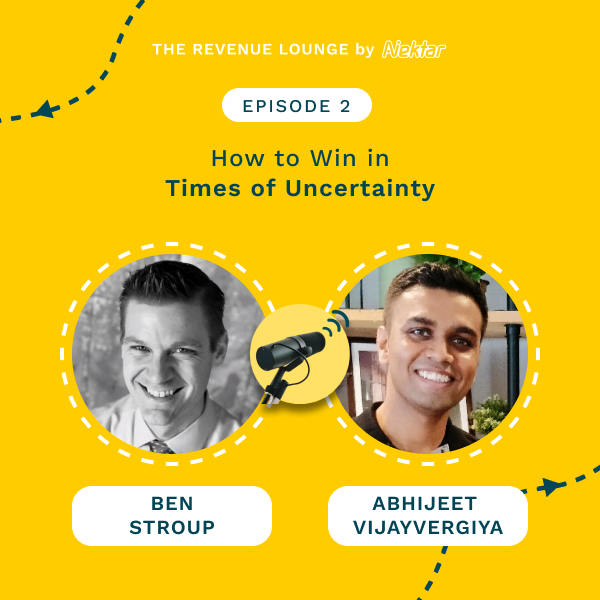
Ep #2: How to Win in Times of Uncertainty
Listen Now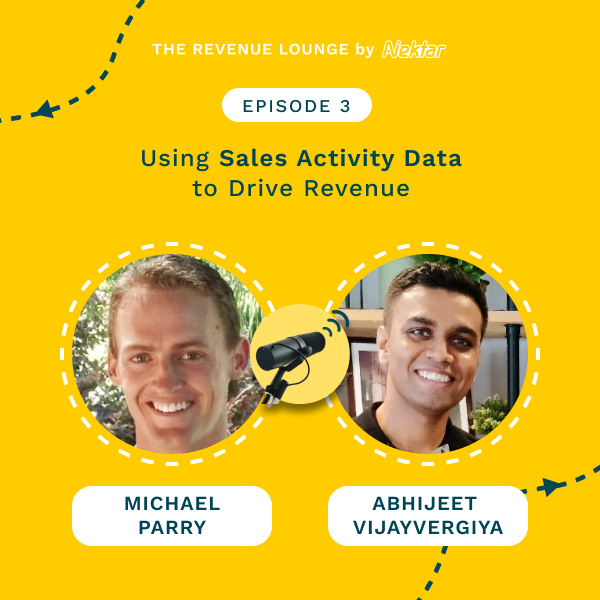
Ep #3: Using Activity Data to Drive Sales Productivity
Listen Now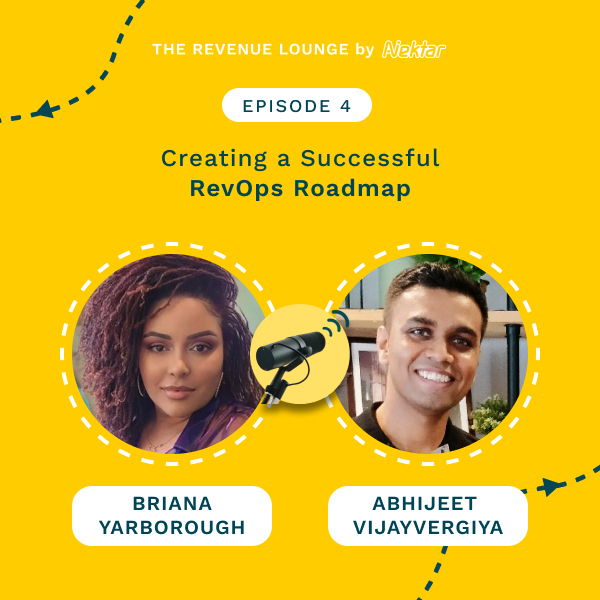
Ep #4: Creating a Successful RevOps Roadmap
Listen Now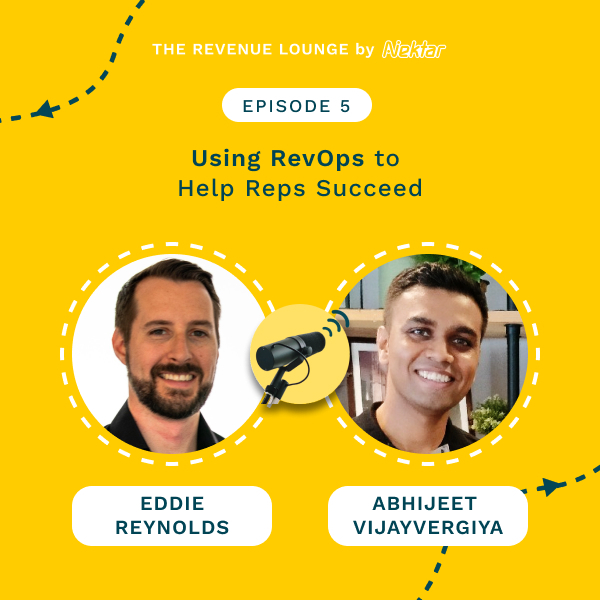
Ep #5: Using RevOps to Help Reps Succeed
Listen Now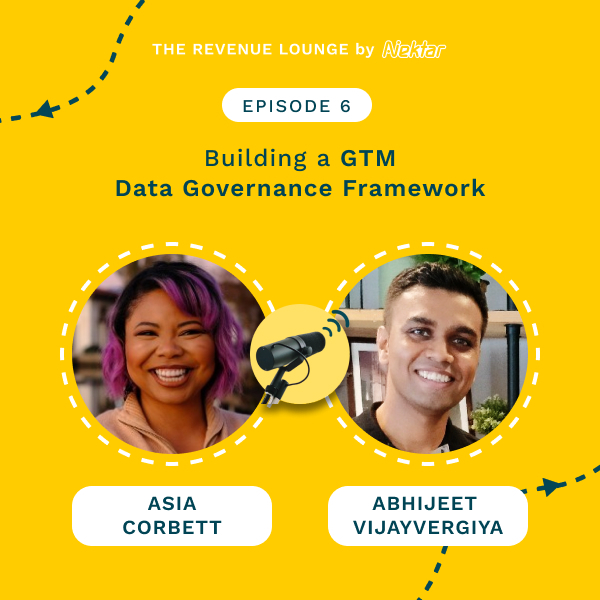
Ep #6: Building a GTM Data Governance Framework
Listen Now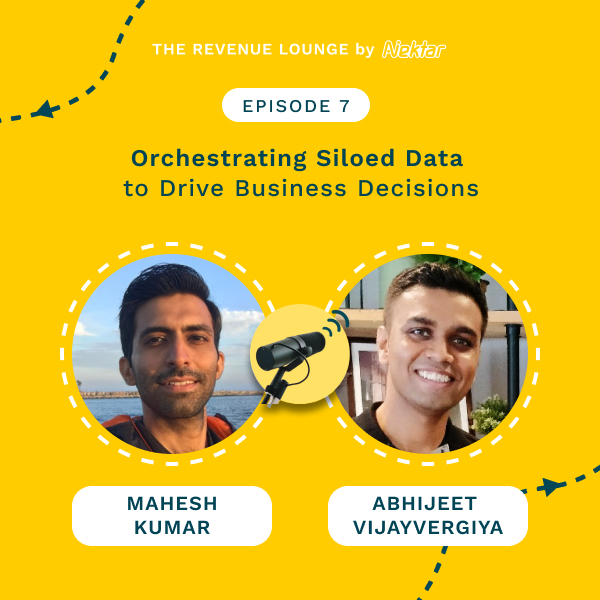
Ep #7: Orchestrating Siloed Data to Drive Business Decisions
Listen Now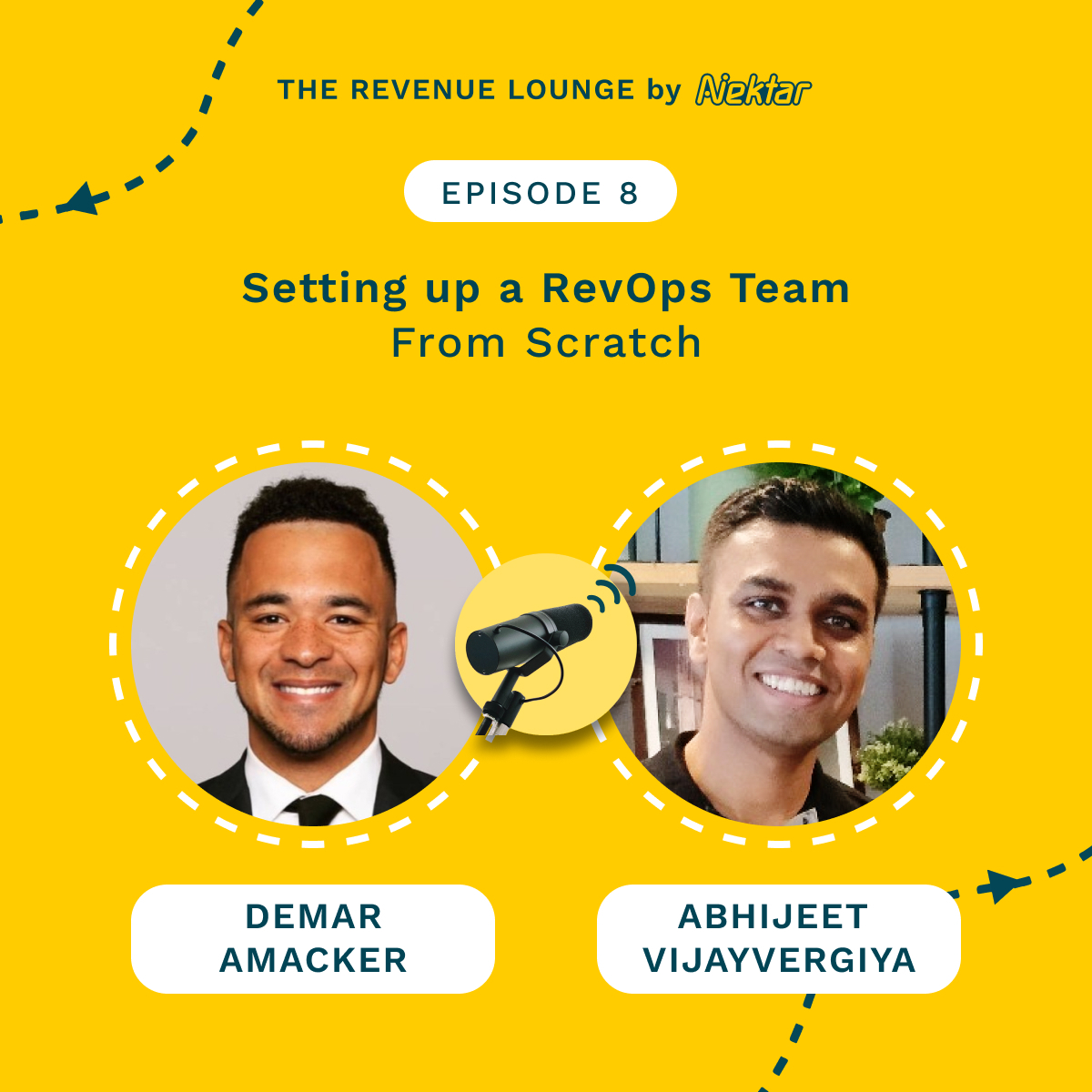
Ep #8: Setting Up a RevOps Team From Scratch
Listen Now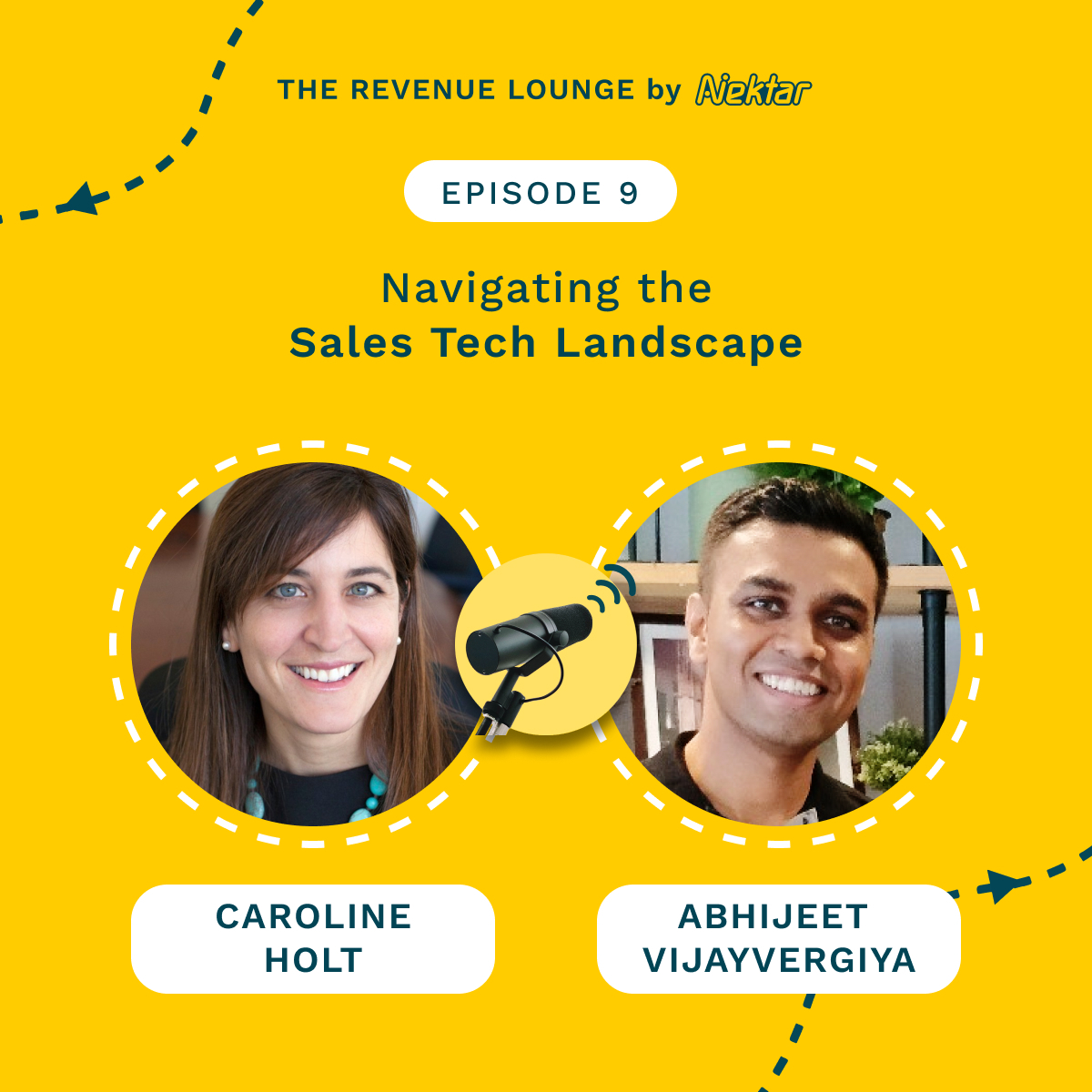
Ep #9: Navigating the Sales Tech Landscape
Listen Now